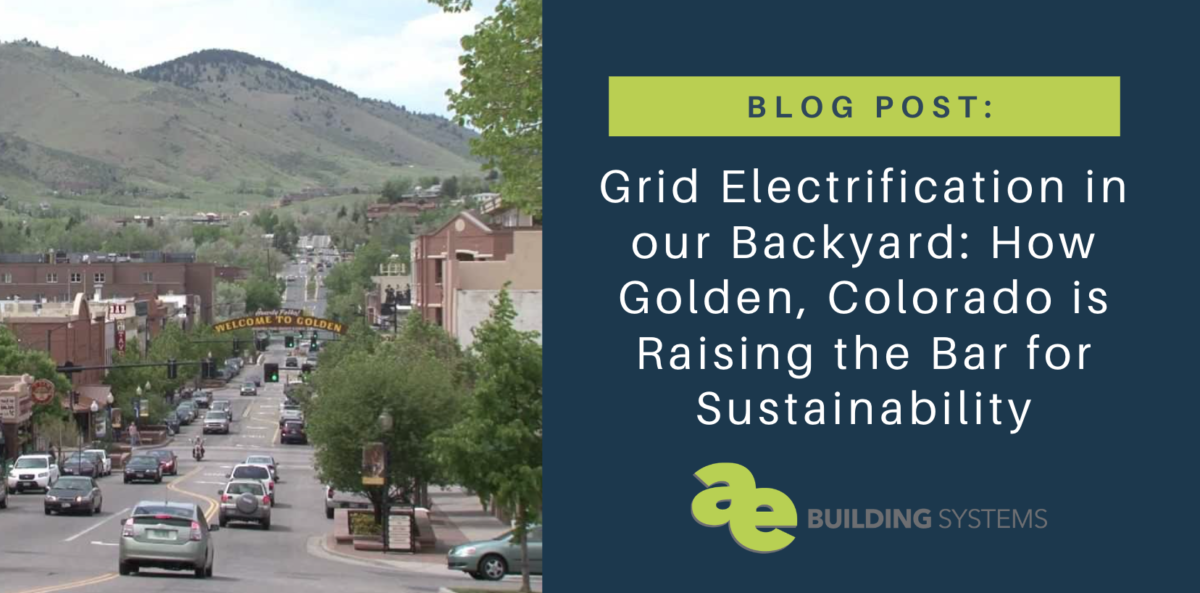The high-altitude hamlet of Golden, Colorado is making waves with its initiative to mandate all-electric building construction in 2024. This new construction requirement is aligned with the city’s climate action goals, which aim to achieve 100% renewable energy for heating by 2050. In doing so, Golden is setting the example for other towns and cities as they embrace grid electrification and less reliance on fossil fuels.
Grid Electrification
Electrification refers to the process of replacing technologies that use fossil fuels (coal, oil, and natural gas) with technologies that use electricity as a source of energy. Many local jurisdictions in the region, including Golden, are taking a hard look at how to retrofit their existing infrastructure to move away from fossil fuels and how to set codes and regulations for future construction.
Building a Roadmap
The city has already adopted the 2021 national building codes and has identified several initiatives to pursue renewable energy in line with the Paris Agreement. However, the city council is taking another step further. They have directed staff members to continue working on a roadmap but with additional research and public meetings to resolve concerns about a proposed requirement for all New Construction for now. This requirement includes all-electric, net-zero with on-site renewable generation, that some community members see as problematic.
The efforts to eliminate natural gas from buildings are gaining traction in local communities. Many Colorado jurisdictions are still undecided about whether to ban natural gas or other fossil fuels for space and water heating. Some have decided to lay the groundwork for all-electric without actually raising that bar. In contrast, Crested Butte was the first jurisdiction in the state to ban natural gas for new development, except in special cases like restaurants and certain commercial uses. Golden is gathering intel on all of these use cases to set a roadmap for their guidelines.
The Golden Challenge
Golden faces a unique challenge as the city is largely developed, which limits new construction primarily to infill or replacement of existing buildings. In the last five years, Golden has had no more than 17 new single-family houses in any given year, and the maximum for one year was eight commercial buildings. Theresa Worsham, the sustainability director for Golden, emphasized that “each community’s needs are likely going to be different, and its decarbonization plans need to be similarly different.”
Four Strategies Toward Electrification & Sustainability
Golden has adopted four strategies to achieve its goals:
One strategy is to require owners of commercial buildings of 5,000 square feet or more to track their emissions. The state now has a similar requirement for buildings 50,000 square feet or more. The idea is to get building owners and managers to understand their emissions, with the potential for instituting programs in the future that may seek to reduce emissions. Among the city’s goals, adopted with the Paris Agreement, is to squeeze energy use in all buildings by 15% through efficiency measures.
The second strategy is to commit the city to further research during 2023 and beyond about how to convert existing buildings toward net-zero all-electric in the coming years. This strategy did not receive much attention during the city council meeting.
The third strategy is to find ways to address building retrofits. Ken Jacobs, a former member of the sustainability board, suggests that the most effective policy would trigger the net-zero requirement if the remodeling is extensive enough to require new heating systems.
The last and most prominent strategy is the proposed requirement for on-site renewable generation. While it might easily be possible to import all of Golden’s electricity from distant wind and solar farms, the groups concluded that the city has a moral responsibility to generate electricity locally. This also has the advantage of furthering the city’s interest in resilience. The proposed regulation would require that on-site energy storage be deployed or off-site solar via solar gardens located in Golden. The last resort would be to purchase renewable energy credits for renewable energy systems located in Colorado.
A Complex Challenge
It sounds like a great idea, but when you dig into the nuts and bolts of executing requirements like these, you start to see where it becomes a challenge. For a town like Golden, which is largely developed and landlocked, you can easily understand the limitations for access to solar fields or physical space to produce its own energy. There are often added costs to newer technology and infrastructure, as well as new questions and concerns no one has had to think about yet in building code requirements. And, the question of what to do with existing buildings is a challenge as well, posing many to consider if a dual source between fossil fuels and electrification can coincide.
It’s simply a complex problem.
Even though it is complex, towns like Golden are willing to tackle it! The benefits of sustainability are obvious, especially when they align with the town’s values. Building an energy ecosystem focused on electrification also allows for greater resilience when one energy source is lagging due to cloudy days, skyrocketing fossil fuel costs, or other hiccups that cause disruption in the energy source availability.
It’s fun to see a local municipality taking on the challenge! The hope is that other towns in Colorado, and the region, take on the challenge as well. As a result, we’ll see better management of our earth’s resources, greater sustainability, greater resiliency, and greater awareness of how electrification can benefit a community. We’re excited to see how this plays out in our own backyard here in nearby Golden, Colorado!

